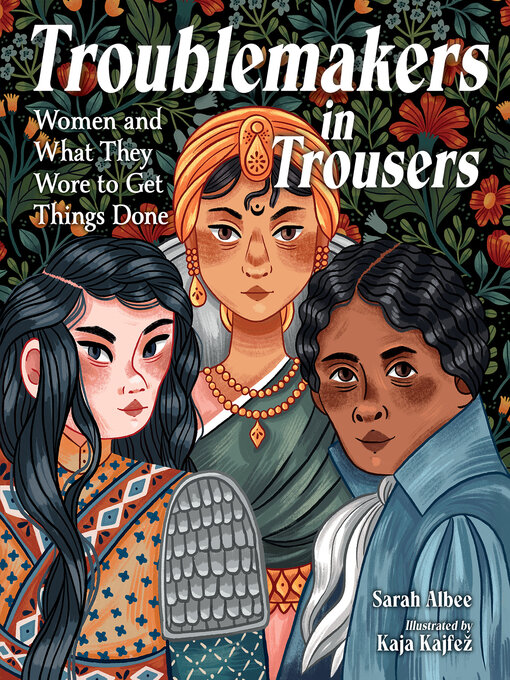Troublemakers in Trousers
Women and What They Wore to Get Things Done
Girls and women have historically been denied access to work, been blocked from the arts, refused the opportunity to lead and fight, and much more, simply because of their gender. From Hatshepsut to Joan of Arc to Frida Kahlo, Troublemakers in Trousers highlights twenty-one women who, for different reasons, wore men’s clothing, pretended to be men, and broke the rules in order to do something they wanted—or needed—to do.
The perfect modern-day introduction to women throughout history who broke boundaries and pushed the limits set by society.
-
Creators
-
Publisher
-
Release date
October 25, 2022 -
Formats
-
Kindle Book
-
OverDrive Read
- ISBN: 9781632898531
-
EPUB ebook
- ISBN: 9781632898531
- File size: 82792 KB
-
-
Languages
- English
-
Levels
- Lexile® Measure: 990
- Text Difficulty: 5-7
-
Reviews
-
School Library Journal
August 1, 2022
Gr 4-9-It wasn't until 2013 that France finally repealed a law against women wearing pants. The prolific Albee explores the impact of social mores in which women had to break the law, confounding social order to achieve their goals-in pants. With such an engaging premise, the stories of 20 women are detailed, from Queen Hatshepsut to Marcenia "Toni" Stone, the first woman to play major-league baseball. Women disguised themselves as men for many reasons: fighting for freedom, supporting their families, and creating art. Well-chosen insets broaden the historical context that triggered their choices. Fascinating facts like "silk wouldn't tear if an arrow pierced the body, making it easier to yank the arrow out" informed Mongol soldier Khutulun's fashion choices. Readers learn of the hostility toward women and discover the lengths they went to-such as walking 150 miles to enlist in the Union army, as Deborah Sampson did. Kajfez's colorful, full-page portraits open chapters in a carefully detailed, cartoon style that counters the primary source images. Illustrations, photos, maps, and carefully selected visuals authenticate the subjects, although captions are occasionally too brief. The strength of these short biographies is the subjects themselves; a diverse, international, and exceptional group. VERDICT Albee delivers in-depth portraits enticing enough to inspire further study; for all middle grade nonfiction collections.-Janet S. Thompson
Copyright 2022 School Library Journal, LLC Used with permission.
-
Booklist
October 1, 2022
Grades 4-7 In Paris, France, it wasn't until 2013 that a law against women wearing pants in public was revoked. Fascinating facts like this color the pages of this engaging collective biography, featuring a diverse range of 21 rule-breaking, nonconforming women from around the world who dressed in men's clothing to pursue their dreams. Some are better known than others: Frida Kahlo, Joan of Arc, Harriet Tubman, and Marguerite Johnson (who became Maya Angelou). Others are less familiar, like the 1700s Jeanne Baret, the first woman to sail around the world; Khutulun, a thirteenth-century Mongolian wrestler; or Black baseball player Marcenia "Toni" Stone. Some wore men's clothing to escape, like Ellen Craft, an enslaved woman who fled north disguised as a wealthy white man. Others did so because they liked it, for practical reasons, or to support their families. Whatever the case, their stories, accompanied by Kajfez's beautifully illustrated portraits, are empowering and inspiring.COPYRIGHT(2022) Booklist, ALL RIGHTS RESERVED.
-
Kirkus
November 15, 2022
Twenty capsule biographies of historical women who wore trousers or men's clothing. The women portrayed in these short, illustrated narratives wore traditionally male clothing for different reasons. Harriet Tubman found skirts to be a hinderance when helping enslaved people escape; Vesta Tilley was an English-born drag performer during the late 19th and early 20th centuries. Many of the women disguised themselves as men so they could work in professions forbidden to women, while Ellen Craft disguised herself to escape slavery. The pharaoh Hatshepsut portrayed herself as male because that's what pharaohs were, and if Frida Kahlo were alive today, "we might describe her as gender fluid." Historical photographs and paintings add interest, although with descriptions pushed to endnotes, their often intriguing context is hard to find. A contemporary, slangy voice wavers between forced and quite funny, and the sidebars that pepper the collection (on everything from smallpox to the gender spectrum to "How To Start Up a Model T") are informative and mostly rather interesting. About half of the subjects are White, though Black, Native American, Mongolian, and Indian women are covered as well. Almost all are from the 18th and 19th centuries in the United States or Western Europe. The final biography (of Marguerite Johnson, streetcar conductor) has such a satisfying reveal that it brings thematic closure to the whole collection. Colorful, fun, relatable tastes of history that may tempt readers into further research. (author's note, notes, bibliography, image credits, index) (Nonfiction. 9-11)COPYRIGHT(2022) Kirkus Reviews, ALL RIGHTS RESERVED.
-
Formats
- Kindle Book
- OverDrive Read
- EPUB ebook
Languages
- English
Levels
- Lexile® Measure:990
- Text Difficulty:5-7
Loading
Why is availability limited?
×Availability can change throughout the month based on the library's budget. You can still place a hold on the title, and your hold will be automatically filled as soon as the title is available again.
The Kindle Book format for this title is not supported on:
×Read-along ebook
×The OverDrive Read format of this ebook has professional narration that plays while you read in your browser. Learn more here.



